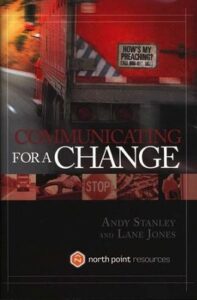Creating a Memorable Sermon Sentence
Creating a Memorable Sermon Sentence
In this post we are going to discover how to go about creating a memorable sermon sentence that will cause people to remember your sermon. In the last post, we started a consideration of this skill, as you remember if you frequent this blog.
Examples of Power Packed Sermon Sentences
One of the “pros” in using the idea of Anaphora that we explored last time is Andy Stanley, leader of  North Point Community Church in Atlanta, Georgia. Andy is an outstanding communicator, and has learned well how to go about creating a memorable sermon sentence for his messages. Here is a selection from his 30 top sentences, as recorded in his book, Communicating for Change:
North Point Community Church in Atlanta, Georgia. Andy is an outstanding communicator, and has learned well how to go about creating a memorable sermon sentence for his messages. Here is a selection from his 30 top sentences, as recorded in his book, Communicating for Change:
1. My past will remind me but it will not define me.
2. Don’t give up what you want most for what you want now.
3. Do for one what you wish you could do for everyone.
4. It’s much easier to make a point than to make a difference.
6. Direction, not intention, determines destination.
14. Your friends will influence the quality and direction of your life.
15. The value of your life is determined by how much of it you give away.
18. What would an extraordinary version of you do today?
19. Rules are confirmation, not a condition, of a relationship with God.
20. You may need to lower your standard of living to raise your quality of life.
27. What and who you listen to will influence what you do.
28. What we believe determines how we behave.
That’s obviously quite a list! Imagine the power of these sentences when they are repeated throughout a sermon!
How To Create a Memorable Sermon Sentence
So, if you want to make your sermon memorable, give thought to using this technique of anaphora.
As I said in the last post, I’m trying it this week. It is Easter Sunday this week, and I have the privilege of preaching on John 20, the Apostle’s recollection of the events around the resurrection. I’m planning on creating a “Before And After” sermon. In other words, we’re going to look at several people in the story and their actions and attitudes before they realized Jesus was alive. Then we’re going to look at the “After” picture.
For instance, there’s Mary Magdalene. We know a great deal about this woman who followed Jesus. Here is a summary from Wikipedia of what we know about her:
 The Gospel of Luke 8:2–3 lists Mary Magdalene as one of the women who traveled with Jesus and helped support his ministry “out of their resources”, indicating that she was probably wealthy. The same passage also states that seven demons had been driven out of her, a statement which is repeated in Mark 16. In all the four canonical gospels, Mary Magdalene was a witness to the crucifixion of Jesus and, in the Synoptic Gospels, she was also present at his burial. All the four gospels identified her, either alone or as a member of a larger group of women which includes Jesus’s mother, as the first to witness the empty tomb, and, either alone or as a member of a group, as the first to witness Jesus’s resurrection.
The Gospel of Luke 8:2–3 lists Mary Magdalene as one of the women who traveled with Jesus and helped support his ministry “out of their resources”, indicating that she was probably wealthy. The same passage also states that seven demons had been driven out of her, a statement which is repeated in Mark 16. In all the four canonical gospels, Mary Magdalene was a witness to the crucifixion of Jesus and, in the Synoptic Gospels, she was also present at his burial. All the four gospels identified her, either alone or as a member of a larger group of women which includes Jesus’s mother, as the first to witness the empty tomb, and, either alone or as a member of a group, as the first to witness Jesus’s resurrection.
Before
Before she meets Jesus, she’s a wreck, weeping in despair. The one person who had given her a new life, free from demons, was now gone. So, she’s wailing outside the tomb. She’s seen plenty of evidence for believing in the resurrection: open tomb and angels, but can’t truly see the risen Lord.
I suppose you know people like this, right? They’ve been beaten down by life, and so believing is a challenge. Right now I have one man in mind. He made a lot of bad choices, and as a result, had a life that was characterized by the demonic.

Thomas meets Jesus
Thomas the doubter had become a cynic. He had been so disappointed by Jesus, that he refused to believe the story of the resurrection. He could see the evidence of resurrection in the other ten disciples, but was locked into keeping from disappointment.
Peter is the third person. John and he both run to the tomb and see the same things, and John believes, but Peter doesn’t. Why? I speculated that it was because of his failure. His last view of Jesus was a look right after Peter’s third denial. So, he could see evidence, but that wasn’t enough for him to see and believe.
After
Needless to say, everything changed with the resurrection. The phrase I developed for this message was this one: They could see evidence around them, but they couldn’t truly see until they met Jesus. Then I challenged people to go out with the news, sent out by Jesus himself to the hurting, the cynical and the failures of the world. Creating a memorable sermon sentence was not easy, and this one was only partly successful, but it helped focus the sermon.
Consider using anaphora. For a further explanation how this works, please see the short video below.



